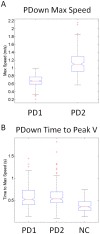Spatial-orientation priming impedes rather than facilitates the spontaneous control of hand-retraction speeds in patients with Parkinson's disease
- PMID: 23843963
- PMCID: PMC3700979
- DOI: 10.1371/journal.pone.0066757
Spatial-orientation priming impedes rather than facilitates the spontaneous control of hand-retraction speeds in patients with Parkinson's disease
Abstract
Background: Often in Parkinson's disease (PD) motor-related problems overshadow latent non-motor deficits as it is difficult to dissociate one from the other with commonly used observational inventories. Here we ask if the variability patterns of hand speed and acceleration would be revealing of deficits in spatial-orientation related decisions as patients performed a familiar reach-to-grasp task. To this end we use spatial-orientation priming which normally facilitates motor-program selection and asked whether in PD spatial-orientation priming helps or hinders performance.
Methods: To dissociate spatial-orientation- and motor-related deficits participants performed two versions of the task. The biomechanical version (DEFAULT) required the same postural- and hand-paths as the orientation-priming version (primed-UP). Any differences in the patients here could not be due to motor issues as the tasks were biomechanically identical. The other priming version (primed-DOWN) however required additional spatial and postural processing. We assessed in all three cases both the forward segment deliberately aimed towards the spatial-target and the retracting segment, spontaneously bringing the hand to rest without an instructed goal.
Results and conclusions: We found that forward and retracting segments belonged in two different statistical classes according to the fluctuations of speed and acceleration maxima. Further inspection revealed conservation of the forward (voluntary) control of speed but in PD a discontinuity of this control emerged during the uninstructed retractions which was absent in NC. Two PD groups self-emerged: one group in which priming always affected the retractions and the other in which only the more challenging primed-DOWN condition was affected. These PD-groups self-formed according to the speed variability patterns, which systematically changed along a gradient that depended on the priming, thus dissociating motor from spatial-orientation issues. Priming did not facilitate the motor task in PD but it did reveal a breakdown in the spatial-orientation decision that was independent of the motor-postural path.
Conflict of interest statement
Figures











Similar articles
-
[A rapid detection of motor block in patients with Parkinson disease during volitional movements of the hand].Srp Arh Celok Lek. 2002 Nov-Dec;130(11-12):376-81. doi: 10.2298/sarh0212376p. Srp Arh Celok Lek. 2002. PMID: 12751160 Serbian.
-
Spatial orientation and postural control in patients with Parkinson's disease.Gait Posture. 2018 Feb;60:50-54. doi: 10.1016/j.gaitpost.2017.11.011. Epub 2017 Nov 13. Gait Posture. 2018. PMID: 29153480
-
Deficits in the evolution of hand preshaping in Parkinson's disease.Neuropsychologia. 2004;42(1):82-94. doi: 10.1016/s0028-3932(03)00150-7. Neuropsychologia. 2004. PMID: 14615078 Clinical Trial.
-
[Computerized method for arm movement assessment in Parkinson's disease and cerebellar syndrome patients].Srp Arh Celok Lek. 2005 Jan-Feb;133(1-2):14-20. Srp Arh Celok Lek. 2005. PMID: 16053170 Serbian.
-
Control of aperture closure initiation during reach-to-grasp movements under manipulations of visual feedback and trunk involvement in Parkinson's disease.Exp Brain Res. 2010 Mar;201(3):509-25. doi: 10.1007/s00221-009-2064-2. Epub 2009 Nov 10. Exp Brain Res. 2010. PMID: 19902195
Cited by
-
Motor output variability, deafferentation, and putative deficits in kinesthetic reafference in Parkinson's disease.Front Hum Neurosci. 2014 Oct 21;8:823. doi: 10.3389/fnhum.2014.00823. eCollection 2014. Front Hum Neurosci. 2014. PMID: 25374524 Free PMC article.
-
Characterization of Sensory-Motor Behavior Under Cognitive Load Using a New Statistical Platform for Studies of Embodied Cognition.Front Hum Neurosci. 2018 Apr 6;12:116. doi: 10.3389/fnhum.2018.00116. eCollection 2018. Front Hum Neurosci. 2018. PMID: 29681805 Free PMC article.
-
Aging with Autism Departs Greatly from Typical Aging.Sensors (Basel). 2020 Jan 20;20(2):572. doi: 10.3390/s20020572. Sensors (Basel). 2020. PMID: 31968701 Free PMC article.
-
Motor Signatures in Digitized Cognitive and Memory Tests Enhances Characterization of Parkinson's Disease.Sensors (Basel). 2022 Jun 11;22(12):4434. doi: 10.3390/s22124434. Sensors (Basel). 2022. PMID: 35746215 Free PMC article.
-
The Autonomic Nervous System Differentiates between Levels of Motor Intent and End Effector.J Pers Med. 2020 Jul 31;10(3):76. doi: 10.3390/jpm10030076. J Pers Med. 2020. PMID: 32751933 Free PMC article.
References
-
- Shadmehr R, Wise SP (2005) The computational neurobiology of reaching and pointing : a foundation for motor learning. Cambridge, Mass.: MIT Press. xvii, 575 p.
-
- Soechting JF, Flanders M (1991) Arm movements in three-dimensional space: computation, theory, and observation. Exerc Sport Sci Rev 19: 389–418. - PubMed
-
- Soechting JF, Flanders M (1992) Moving in three-dimensional space: frames of reference, vectors, and coordinate systems. Annu Rev Neurosci 15: 167–191. - PubMed
-
- Nishikawa KC, Murray ST, Flanders M (1999) Do arm postures vary with the speed of reaching? J Neurophysiol 81: 2582–2586. - PubMed
-
- Desmurget M, Grea H, Prablanc C (1998) Final posture of the upper limb depends on the initial position of the hand during prehension movements. Exp Brain Res 119: 511–516. - PubMed
Publication types
MeSH terms
LinkOut - more resources
Full Text Sources
Other Literature Sources
Medical

